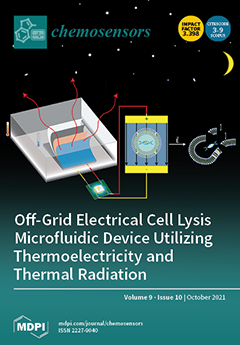Open AccessArticle
Thiourea Organocatalysts as Emerging Chiral Pollutants: En Route to Porphyrin-Based (Chir)Optical Sensing
by
Nele Konrad, Matvey Horetski, Mariliis Sihtmäe, Khai-Nghi Truong, Irina Osadchuk, Tatsiana Burankova, Marc Kielmann, Jasper Adamson, Anne Kahru, Kari Rissanen, Mathias O. Senge, Victor Borovkov, Riina Aav and Dzmitry Kananovich
Cited by 6 | Viewed by 5195
Abstract
Environmental pollution with chiral organic compounds is an emerging problem requiring innovative sensing methods. Amino-functionalized thioureas, such as 2-(dimethylamino)cyclohexyl-(3,5-bis(trifluoromethyl)phenyl)thiourea (Takemoto’s catalyst), are widely used organocatalysts with virtually unknown environmental safety data. Ecotoxicity studies based on the
Vibrio fischeri luminescence inhibition test reveal significant
[...] Read more.
Environmental pollution with chiral organic compounds is an emerging problem requiring innovative sensing methods. Amino-functionalized thioureas, such as 2-(dimethylamino)cyclohexyl-(3,5-bis(trifluoromethyl)phenyl)thiourea (Takemoto’s catalyst), are widely used organocatalysts with virtually unknown environmental safety data. Ecotoxicity studies based on the
Vibrio fischeri luminescence inhibition test reveal significant toxicity of Takemoto’s catalyst (EC
50 = 7.9 mg/L) and its NH
2-substituted analog (EC
50 = 7.2–7.4 mg/L). The observed toxic effect was pronounced by the influence of the trifluoromethyl moiety. En route to the porphyrin-based chemosensing of Takemoto-type thioureas, their supramolecular binding to a series of zinc porphyrins was studied with UV-Vis and circular dichroism (CD) spectroscopy, computational analysis and single crystal X-ray diffraction. The association constant values generally increased with the increasing electron-withdrawing properties of the porphyrins and electron-donating ability of the thioureas, a result of the predominant Zn
N cation–dipole (Lewis acid–base) interaction. The binding event induced a CD signal in the Soret band region of the porphyrin hosts—a crucial property for chirality sensing of Takemoto-type thioureas.
Full article
►▼
Show Figures





